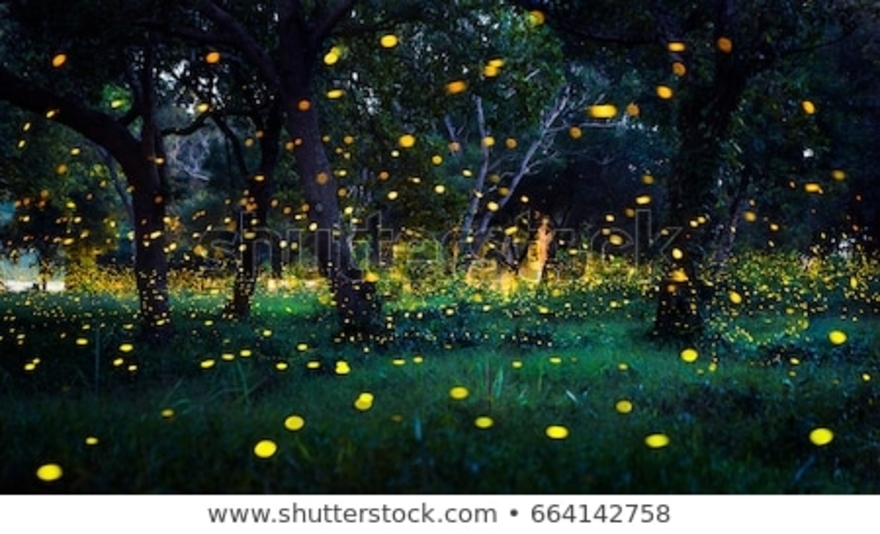Elkmont Fireflies in the Smoky Mountains

Alaina & I were standing out in the back yard watching her Dad mow the lawn as it was getting dark. He has no other time to do it and so we stood chatting with him as he walked up and down. Suddenly I noticed specks of light, lighting up and going off intermittently and realised we were looking at Fire flies or Lightening bugs as the Americans call them.
As children we enjoyed seeing them in our little village in Goa. However they cannot be seen there any more.
The bugs we saw in Tennessee were the Synchronous Elkmont Fireflies, which can be found in the Smoky Mountains. Fireflies, or lightning bugs according to the neighbour who is a great nature lover says they can be found all over the eastern parts of North America, but the Great Smoky Mountains is one destination that attracts thousands of visitors year after year to see the Elkmont fireflies Synchronous fireflies (Photinus carolinus). They are one of at least 19 species of fireflies that live in Great Smoky Mountains National Park. They are the only species in America which can synchronize their flashing light patterns.
Fireflies are beetles which take from one to two years to mature from larvae, but will live as adults for only about 21 days. While in the larval stage, the insects feed on snails and smaller insects. Once they transform into their adult form, they do not eat.
Their light patterns are part of their mating display. Each species of firefly has a characteristic flash pattern that helps its male and female individuals recognize each other. Most species produce a greenish-yellow light; and one species has a bluish light. The males fly and flash and the usually stationary females respond with a flash. Peak flashing for synchronous fireflies in the Smoky Mountains park is normally within a two-week period in late May to mid-June.
Reading up about the phenomenon one learns that the production of light by living organisms is called bioluminescence. Fireflies are a good example of an organism that bioluminesce, but there are others as well, such as certain species of fungus, fish, shrimp, jellyfish, plankton, glowworms, gnats, snails, and springtails.
Bioluminescence involves highly efficient chemical reactions that result in the release of particles of light with little or no emission of heat. Fireflies combine the chemical luciferin and oxygen with the enzyme luciferase in their lanterns (part of their abdomens) to make light. The light produced is referred to as a "cold" light, with nearly 100% of the energy given off as light. In contrast, the energy produced by an incandescent light bulb is approximately 10% light and 90% heat.
No one is sure why the fireflies flash synchronously. Competition between males may be one reason: they all want to be the first to flash. Or perhaps if the males all flash together they have a better chance of being noticed, and the females can make better comparisons.
The fireflies do not always flash in unison. They may flash in waves across hillsides, and at other times will flash randomly. Synchrony occurs in short bursts that end with abrupt periods of darkness.
As the season begins, a few insects start flashing, then more join the display as the days pass. They reach a "peak" when the greatest number of insects are found displaying. After peak, the numbers gradually decline each day until the mating season is over. Since 1993, this peak date has occurred at various times from the third week of May to the third week in June.
During the two week long mating season, the quality of individual nightly displays can be affected by environmental factors. On misty, drippy evenings following rainfall, the insects may not readily display. Cool temperatures, below 50º Fahrenheit, will also shut down the display for the night. The Moon phase has been observed to affect the timing of nightly displays-on nights with a bright moon, the insects may begin flashing a bit later than usual.
As children we enjoyed seeing them in our little village in Goa. However they cannot be seen there any more.
The bugs we saw in Tennessee were the Synchronous Elkmont Fireflies, which can be found in the Smoky Mountains. Fireflies, or lightning bugs according to the neighbour who is a great nature lover says they can be found all over the eastern parts of North America, but the Great Smoky Mountains is one destination that attracts thousands of visitors year after year to see the Elkmont fireflies Synchronous fireflies (Photinus carolinus). They are one of at least 19 species of fireflies that live in Great Smoky Mountains National Park. They are the only species in America which can synchronize their flashing light patterns.
Fireflies are beetles which take from one to two years to mature from larvae, but will live as adults for only about 21 days. While in the larval stage, the insects feed on snails and smaller insects. Once they transform into their adult form, they do not eat.
Their light patterns are part of their mating display. Each species of firefly has a characteristic flash pattern that helps its male and female individuals recognize each other. Most species produce a greenish-yellow light; and one species has a bluish light. The males fly and flash and the usually stationary females respond with a flash. Peak flashing for synchronous fireflies in the Smoky Mountains park is normally within a two-week period in late May to mid-June.
Reading up about the phenomenon one learns that the production of light by living organisms is called bioluminescence. Fireflies are a good example of an organism that bioluminesce, but there are others as well, such as certain species of fungus, fish, shrimp, jellyfish, plankton, glowworms, gnats, snails, and springtails.
Bioluminescence involves highly efficient chemical reactions that result in the release of particles of light with little or no emission of heat. Fireflies combine the chemical luciferin and oxygen with the enzyme luciferase in their lanterns (part of their abdomens) to make light. The light produced is referred to as a "cold" light, with nearly 100% of the energy given off as light. In contrast, the energy produced by an incandescent light bulb is approximately 10% light and 90% heat.
No one is sure why the fireflies flash synchronously. Competition between males may be one reason: they all want to be the first to flash. Or perhaps if the males all flash together they have a better chance of being noticed, and the females can make better comparisons.
The fireflies do not always flash in unison. They may flash in waves across hillsides, and at other times will flash randomly. Synchrony occurs in short bursts that end with abrupt periods of darkness.
As the season begins, a few insects start flashing, then more join the display as the days pass. They reach a "peak" when the greatest number of insects are found displaying. After peak, the numbers gradually decline each day until the mating season is over. Since 1993, this peak date has occurred at various times from the third week of May to the third week in June.
During the two week long mating season, the quality of individual nightly displays can be affected by environmental factors. On misty, drippy evenings following rainfall, the insects may not readily display. Cool temperatures, below 50º Fahrenheit, will also shut down the display for the night. The Moon phase has been observed to affect the timing of nightly displays-on nights with a bright moon, the insects may begin flashing a bit later than usual.

Related Articles
Editor's Picks Articles
Top Ten Articles
Previous Features
Site Map
Content copyright © 2023 by Marianne de Nazareth. All rights reserved.
This content was written by Marianne de Nazareth. If you wish to use this content in any manner, you need written permission. Contact Marianne de Nazareth for details.





 -resizeimage.jpg.jpg)

